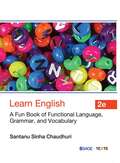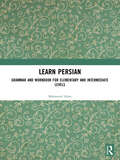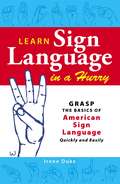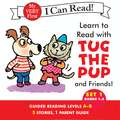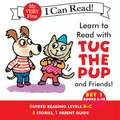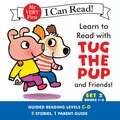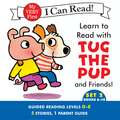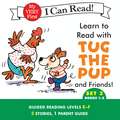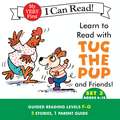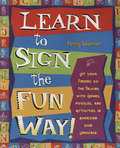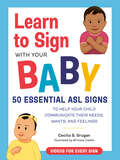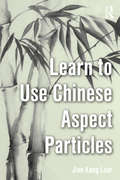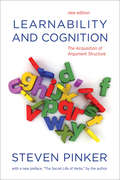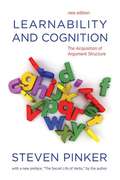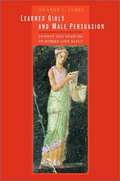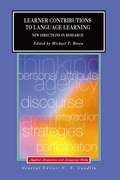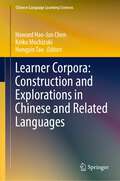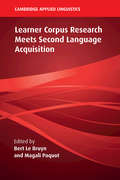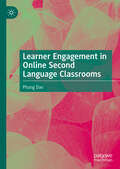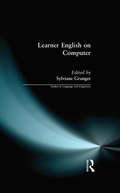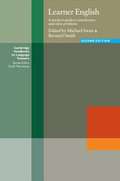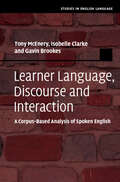- Table View
- List View
Learn English: A Fun Book of Functional Language, Grammar, and Vocabulary
by Santanu Sinha ChaudhuriA one-book army that will demolish your fear of and troubles with English! If you wish to improve your English but don't know where to begin, try reading this book. Learn English is a complete package that presents the fundamentals of the English language in an enjoyable, reader-friendly style. From basic sentences to complex grammatical forms, from essential English words to modern business vocabulary, and from common errors to elements of style, this book covers them all! As you work through the book, you will find answers to your questions in easy-to-understand, informal language. The book is specifically aimed at South Asians who face similar challenges while learning English. With contexts and stories they can easily relate to, this book offers insights into English in a fun way. It will help you speak and write English with clarity and confidence. This book: • Can an be used either by self-learners or in a classroom • Is based on modern concepts of second language acquisition • Deals with linguistic challenges and cultural aspects from a South Asian perspective
Learn Persian: Grammar and Workbook for Elementary and Intermediate Levels
by Mahmood AlamLearn Persian has a step-by-step organized and structured framework of modern Persian words; grammar, short syntactical phrases and idiomatic expressions. Persian has a lot of common words and sounds from Arabic and Urdu; this work highlights vowels and consonants that are covered in the formation of words and sounds with apt precision. The special feature of this book is its simplicity, yet meaningful and comprehensiveness for the study of the language. This should be a good source book for new learners, as well as for those who want to explore the harmony and flair of Persian. It would undoubtedly open doors to a Persian heritage as much as it slowly trains the eager learner in spoken Persian as well. Learn Persian will interest both learners and experts, and an excellent experience of coming across Persian as an interesting living language.
Learn Sign Language in a Hurry
by Irene Duke"I love you." "What can I get you?" "Let's take a walk."Wanting to say simple things like these but not being able to is frustrating and disheartening--but learning how to communicate can be easy and fun! This book is a basic guide to the alphabet, vocabulary, and techniques it takes to connect using American Sign Language. Whether signing out of necessity or learning for the sake of growing, you will enjoy this practical primer. After reading this book, you will be able to use American Sign Language in a social, educational, or professional setting. Whether the goal is to communicate with hearing-impaired grandparent, a child with special needs in school, or an infant, people learn sign language for many different reasons. Easy to read and reference--and complete with images and examples of common signs --this basic guide allows you to make a meaningful connection that's otherwise impossible.
Learn Sign Language in a Hurry: Grasp the Basics of American Sign Language Quickly and Easily
by Irene Duke"I love you.""What can I get you?""Let's take a walk."Wanting to say simple things like these but not being able to is frustrating and disheartening-but learning how to communicate can be easy and fun! This book is a basic guide to the alphabet, vocabulary, and techniques it takes to connect using American Sign Language. Whether signing out of necessity or learning for the sake of growing, you will enjoy this practical primer. After reading this book, you will be able to use American Sign Language in a social, educational, or professional setting.Whether the goal is to communicate with hearing-impaired grandparent, a child with special needs in school, or an infant, people learn sign language for many different reasons. Easy to read and reference-and complete with images and examples of common signs-this basic guide allows you to make a meaningful connection that's otherwise impossible.
Learn to Read with Tug the Pup and Friends! Set 1: Books 1-5 (My Very First I Can Read)
by Dr. Julie WoodBuild your child's beginning reading success with this set of 5 simple and fun storybooks plus a separate parent guide!Written by educator and reading specialist Dr. Julie M. Wood, with lively illustrations by Sebastien Braun, this set of books stars Tug the Pup and an endearing group of characters who will lead beginners through the proven steps for successful reading.The Learn to Read with Tug the Pup books features sight word vocabulary, simple text, strong picture support, and character and plot development. The parent guide lists ideas for building early literacy skills through shared reading, games, and art activities. The 5 stories in this set are Guided Reading Levels A–B, which means it's the perfect entry point for new readers, with simple and predictable stories. Enter into the world of reading with My Very First I Can Read! This comprehensive emergent reading program addresses all the components of reading mastery based on the latest early literacy research.
Learn to Read with Tug the Pup and Friends! Set 1: Books 6-10 (My Very First I Can Read)
by Dr. Julie WoodBuild your child's beginning reading success with this set of 5 simple and fun storybooks plus a separate parent guide!Written by educator and reading specialist Dr. Julie M. Wood, with lively illustrations by Sebastien Braun, this set of books stars Tug the Pup and an endearing group of characters who will lead beginners through the proven steps for successful reading.The Learn to Read with Tug the Pup books features sight word vocabulary, simple text, strong picture support, and character and plot development. The parent guide lists ideas for building early literacy skills through shared reading, games, and art activities. The 5 stories in this set are Guided Reading Levels B-C, which means it's the perfect entry point for new readers, with simple and predictable stories.Enter into the world of reading with My Very First I Can Read! This comprehensive emergent reading program addresses all the components of reading mastery based on the latest early literacy research.
Learn to Read with Tug the Pup and Friends! Set 2: Books 1-5 (My Very First I Can Read)
by Dr. Julie WoodBuild your child's beginning reading success with this set of 5 simple and fun storybooks plus a separate parent guide!Written by educator and reading specialist Dr. Julie M. Wood, with lively illustrations by Sebastien Braun, this set of books stars Tug the Pup and an endearing group of characters who will lead beginners through the proven steps for successful reading.The Learn to Read with Tug the Pup books features sight word vocabulary, simple text, strong picture support, and character and plot development. The parent guide lists ideas for building early literacy skills through shared reading, games, and art activities. The 5 stories in this set are Guided Reading Levels C–D, which means the stories are still very simple but include dialogue and are slightly more advanced than the A and B level stories.Enter into the world of reading with My Very First I Can Read! This comprehensive emergent reading program addresses all the components of reading mastery based on the latest early literacy research.
Learn to Read with Tug the Pup and Friends! Set 2: Books 6-10 (My Very First I Can Read)
by Dr. Julie WoodBuild your child's beginning reading success with this set of 5 simple and fun storybooks plus a separate parent guide!Written by educator and reading specialist Dr. Julie M. Wood, with lively illustrations by Sebastien Braun, this set of books stars Tug the Pup and an endearing group of characters who will lead beginners through the proven steps for successful reading.The Learn to Read with Tug the Pup books features sight word vocabulary, simple text, strong picture support, and character and plot development. The parent guide lists ideas for building early literacy skills through shared reading, games, and art activities. The 5 stories in this set are Guided Reading Levels C–E, which means the stories are still very simple but include dialogue and are slightly more advanced than the A and B level stories.Enter into the world of reading with My Very First I Can Read! This comprehensive emergent reading program addresses all the components of reading mastery based on the latest early literacy research.
Learn to Read with Tug the Pup and Friends! Set 3: Books 1-5 (My Very First I Can Read)
by Dr. Julie WoodBuild your child's beginning reading success with this set of 5 simple and fun storybooks plus a separate parent guide!Written by educator and reading specialist Dr. Julie M. Wood, with lively illustrations by Sebastien Braun, this set of books stars Tug the Pup and an endearing group of characters who will lead beginners through the proven steps for successful reading.The Learn to Read with Tug the Pup books features sight word vocabulary, simple text, strong picture support, and character and plot development. The parent guide lists ideas for building early literacy skills through shared reading, games, and art activities. The 5 stories in this set are Guided Reading Levels E–F, which means the vocabulary, sentence structure, and plots are still simple, but richer than sets one and two.Enter into the world of reading with My Very First I Can Read! This comprehensive emergent reading program addresses all the components of reading mastery based on the latest early literacy research.
Learn to Read with Tug the Pup and Friends! Set 3: Books 6-10 (My Very First I Can Read)
by Dr. Julie WoodBuild your child's beginning reading success with this set of 5 simple and fun storybooks plus a separate parent guide!Written by educator and reading specialist Dr. Julie M. Wood, with lively illustrations by Sebastien Braun, this set of books stars Tug the Pup and an endearing group of characters who will lead beginners through the proven steps for successful reading.The Learn to Read with Tug the Pup books features sight word vocabulary, simple text, strong picture support, and character and plot development. The parent guide lists ideas for building early literacy skills through shared reading, games, and art activities. The 5 stories in this set are Guided Reading Levels F-G, which means the vocabulary, sentence structure, and plots are still simple, but richer than sets one and two.Enter into the world of reading with My Very First I Can Read! This comprehensive emergent reading program addresses all the components of reading mastery based on the latest early literacy research.
Learn to Read: 25 Simple Stories & Activities for Beginner Readers (Learn to Read)
by Kimberly Ann KiedrowskiHelp kids ages 3 to 5 start reading with simple stories and sight words.Encourage your little one to read with 50 essential sight words. From "up" and "down" to "could" and "it," these simple illustrated stories are the perfect summer activities to help early readers recognize words in sentences and understand their meaning. There's even a pair of fun activities after every story to further reinforce what they've learned! It's the perfect summer workbook to keep kids engaged in learning.Get your young reader learning sight words with the science of reading:25 stories—Sight words are introduced gradually, with each story increasing slightly in difficulty. As a summer learning workbook, it reinforces what children learn and keeps them interested as they prepare for preschool and kindergarten.Common sight words—Give your child a solid foundation for reading with top sight words like "many," "time," "go," "out," "do," and "know."Educational activities—At the end of each story you'll find two fun reading games where your child can practice identifying the words they've just read, reinforcing the learning.Discover fun preschool and kindergarten learning activities with this top choice in learn-to-read books for kids 3-5.
Learn to Sign the Fun Way! Let Your Fingers Do the Talking with Games, Puzzles, and Activities in American Sign Language
by Penny WarnerThe perfect guide to signing for everyone! Never before has learning to sign been so simple and so much fun! Whether you are a teacher or a parent, this lively self-guided book of American Sign Language (ASL) will quickly become your kids' new favorite teacher! Learn to Sign the Fun Waygoes beyond the manual alphabet and teaches the beautiful language of sign—the United States' fourth most pervasive language—in a simple, interactive format. Signers-to-be will discover: ·Great games to make learning ASL an entertaining adventure ·Activities for both the individual and the classroom ·Cool groups of signs that appeal esspecially to kids ·And much more! Kids love to sign, whether it be to communicate with a hearing-impaired individual or as a "secret" language with their friends. With this illustrated book they'll quickly and easily become signing superstars! Inside are cool signs for kids, including: ·People signs ·Alphabet and numbers ·Animals ·Food and drinks ·Home signs ·Clothing ·Color ·Sports ·Activity signs ·Thoughts and feelings ·Action signs ·Body parts ·School talk ·Calendar signs ·Silly and fun signs
Learn to Sign with Your Baby: 50 Essential ASL Signs to Help Your Child Communicate Their Needs, Wants, and Fe elings
by Cecilia S. GruganCommunicate, connect, and bond with your baby with 50 essential, easy-to-learn ASL signs.Your baby is crying. Are they hungry or are they tired? With 50 practical ASL signs that cover a child&’s day, Learn to Sign with Your Baby will help you better understand your child and help them communicate with you. Author Cecilia S. Grugan, a Deaf parent, gives you detailed instructions and tips for how to master each sign, as well as helpful advice and fun activities for incorporating ASL into your life with baby. And with clear illustrations and video demonstrations for each sign, you can confidently start signing with your baby—and watch as your bond deepens and strengthens.Learn to Sign with Your Baby includes: 50 of the most useful ASL signs. From &“more&” and &“eat&” to &“change&” and &“hurt,&” this book teaches the most relevant and practical terms for your daily life with baby—and makes signs for specific needs easy to find.Step-by-step color illustrations and video for every sign. The video for each sign can be accessed by a QR code; scan it for step-by-step guidance to confidently and correctly form each sign.Engaging activities make ASL fun. Play a game, sing a song—this book makes incorporating ASL into your life enjoyable and rewarding.Helpful tips. Tips for remembering the signs, how to effectively use them, and what to look for as baby signs back make ASL easy to learn and easy to use.
Learn to Use Chinese Aspect Particles
by Jian Kang LoarAspect in Mandarin Chinese plays an important role in interpreting the temporal information of a sentence. It is an important verbal category, which is concerned with the speaker’s viewpoint or perspective on a situation: whether the situation is presented as complete (perfective aspect) or as ongoing (imperfective aspect), etc. Learning to understand the aspect particles or markers, and use them correctly, has always been one of the most difficult tasks for learners of Chinese. Learn to Use Chinese Aspect Particles is a pedagogical guide designed to equip teachers with necessary aspectual theoretical knowledge, and is aimed at in-service or trainee teachers, and intermediate or advanced students to reinforce teaching and learning. Challenging exercises are designed and explanations for the correct use of an aspect particle are given, thus making the book more useable and convenient to teachers and enhancing the practical reference value of the book.
Learn to Write Badly
by Michael BilligModern academia is increasingly competitive yet the writing style of social scientists is routinely poor and continues to deteriorate. Are social science postgraduates being taught to write poorly? What conditions adversely affect the way they write? And which linguistic features contribute towards this bad writing? Michael Billig's witty and entertaining book analyses these questions in a quest to pinpoint exactly what is going wrong with the way social scientists write. Using examples from diverse fields such as linguistics, sociology and experimental social psychology, Billig shows how technical terminology is regularly less precise than simpler language. He demonstrates that there are linguistic problems with the noun-based terminology that social scientists habitually use - 'reification' or 'nominalization' rather than the corresponding verbs 'reify' or 'nominalize'. According to Billig, social scientists not only use their terminology to exaggerate and to conceal, but also to promote themselves and their work.
Learnability and Cognition, new edition: The Acquisition of Argument Structure (Learning, Development, and Conceptual Change)
by Steven PinkerA classic book about language acquisition and conceptual structure, with a new preface by the author, "The Secret Life of Verbs."Before Steven Pinker wrote bestsellers on language and human nature, he wrote several technical monographs on language acquisition that have become classics in cognitive science. Learnability and Cognition, first published in 1989, brought together two big topics: how do children learn their mother tongue, and how does the mind represent basic categories of meaning such as space, time, causality, agency, and goals? The stage for this synthesis was set by the fact that when children learn a language, they come to make surprisingly subtle distinctions: pour water into the glass and fill the glass with water sound natural, but pour the glass with water and fill water into the glass sound odd. How can this happen, given that children are not reliably corrected for uttering odd sentences, and they don't just parrot back the correct ones they hear from their parents? Pinker resolves this paradox with a theory of how children acquire the meaning and uses of verbs, and explores that theory's implications for language, thought, and the relationship between them.As Pinker writes in a new preface, "The Secret Life of Verbs," the phenomena and ideas he explored in this book inspired his 2007 bestseller The Stuff of Thought: Language as a Window into Human Nature. These technical discussions, he notes, provide insight not just into language acquisition but into literary metaphor, scientific understanding, political discourse, and even the conceptions of sexuality that go into obscenity.
Learnability and Cognition: The Acquisition of Argument Structure (new edition)
by Steven PinkerBefore Steven Pinker wrote bestsellers on language and human nature, he wrote severaltechnical monographs on language acquisition that have become classics in cognitive science. Learnability and Cognition, first published in 1989, brought together two bigtopics: how do children learn their mother tongue, and how does the mind represent basic categoriesof meaning such as space, time, causality, agency, and goals? The stage for this synthesis was setby the fact that when children learn a language, they come to make surprisingly subtle distinctions:pour water into the glass and fill the glass with water soundnatural, but pour the glass with water and fill water into theglass sound odd. How can this happen, given that children are not reliably corrected foruttering odd sentences, and they don't just parrot back the correct ones they hear from theirparents? Pinker resolves this paradox with a theory of how children acquire the meaning and uses ofverbs, and explores that theory's implications for language, thought, and the relationship betweenthem. As Pinker writes in a new preface, "The Secret Life of Verbs," thephenomena and ideas he explored in this book inspired his 2007 bestseller The Stuff ofThought: Language as a Window into Human Nature. These technical discussions, he notes,provide insight not just into language acquisition but into literary metaphor, scientificunderstanding, political discourse, and even the conceptions of sexuality that go intoobscenity.
Learned Girls and Male Persuasion: Gender and Reading in Roman Love Elegy
by Sharon L. JamesThis book does a bold and utterly original thing by reading the Roman love poets from the point of view of the women the poets speak to or about.
Learner Contributions to Language Learning: New Directions in Research (Applied Linguistics and Language Study)
by Michael BreenSince it was first established in the 1970s the Applied Linguistics and Language Study series has become a major force in the study of practical problems in human communication and language education. Drawing extensively on empirical research and theoretical work in linguistics, sociology, psychology and education, the series explores key issues in language acquisition and language use. What the learner contributes is central to the language learning process. Learner Contributions to Language Learning provides a uniquely comprehensive account of learners' personal attributes, their thinking, their feelings, and their actions that have been shown to have an impact upon language learning.Containing specific chapters from leading names in the field, this book provides both a review of what has been discovered from previous research and identifies important future directions for research on learner contributions. It is a landmark volume setting the agenda for language learning research in the 21st century and it provides invaluable information for all those engaged in language teaching.The contributors to the volume are-Michael P. Breen Bonny NortonAnna Chamot Rebecca OxfordRod Ellis Anna PavlenkoJames P. Lantolf Anita WendenDiane Larsen-Freeman
Learner Corpora: Construction and Explorations in Chinese and Related Languages (Chinese Language Learning Sciences)
by Hongyin Tao Howard Hao-Jan Chen Keiko MochizukiThis edited book reflects the state of the art in learner corpus and related approaches to Chinese as a second language (CSL). CSL as a field has flourished in the past few decades due to the increasingly important role of the Chinese language at the world stage, yet studies of Chinese as a second language based on learner corpora have been less well developed due to the limited availability of data and lack of theoretical insights. This book represents the latest research in this area by 1) assembling a large group of active researchers from multiple international research communities (USA, China, Hong Kong, Macau, Japan, Taiwan, and France); 2) discussing the latest resources and technologies in Chinese and other Asian languages learner corpora and corpus building; 3) basing Chinese as a second language studies on data from learners of Chinese with a wide range of first language backgrounds (English, Japanese, Korean, French, among others); and 4) integrating corpus methods with a wide range of related methods in allied fields—language acquisition, usage-based linguistics, psycholinguistics, and neurolinguistics. This comprehensive collection is indispensable for anyone who is interested in corpus approaches to CSL and Chinese applied language studies in general.
Learner Corpus Research Meets Second Language Acquisition (Cambridge Applied Linguistics)
by Magali Paquot Bert Le BruynAdvances in Learner Corpus Research (LCR) and Second Language Acquisition (SLA) have brought these two fast-moving fields significantly closer in recent years. This volume brings together contributions from internationally recognized experts in both LCR and SLA to provide an innovative, cross-collaborative examination of how both areas can provide rich insights for the other. Chapters present recent advances in LCR and illustrate in a clear and accessible style how these can be exploited for the study of a broad range of key topics in SLA, such as complexity, tense and aspect, cross-linguistic influence vs. universal processes, phraseology and variability. It concludes with two commentary chapters written by eminent scholars, one from the perspective of SLA, the other from the perspective of LCR, allowing researchers and students alike to reflect upon the mutually beneficial harmony between the two fields and link up LCR and SLA research and theory.
Learner Engagement in Online Second Language Classrooms
by Phung DaoThis book explores current research on online instructed L2 acquisition, with a specific focus on the nature and impact of learner engagement in online L2 classroom interaction. It examines the topic of online learner engagement from various theoretical perspectives, discusses conceptual and methodological issues, synthesizes research on the role of learner engagement in online L2 classroom interaction, and critically assesses its connection to teaching practices across different L2 settings. The book is intended for a wide audience, including undergraduate and postgraduate Applied Linguistics, TESOL and Second Language Education students seeking to understand the significance of learner engagement in online L2 learning. It will also be useful for researchers interested in staying updated on recent findings regarding the benefits of learner engagement in online classroom interaction for L2 learning. Additionally, teachers, teacher trainers and educators in Teacher Education (TE) and/or continuous professional development (CPD) programs can benefit from the pedagogical insights offered in this book regarding online L2 instruction in various contexts.
Learner English on Computer (Studies in Language and Linguistics)
by Geoffrey Leech Sylviane GrangerThe first book of its kind, Learner English on Computer is intended to provide linguists, students of linguistics and modern languages, and ELT professionals with a highly accessible and comprehensive introduction to the new and rapidly-expanding field of corpus-based research into learner language. Edited by the founder and co-ordinator of the International Corpus of Learner English (ICLE), the book contains articles on all aspects of corpus compilation, design and analysis.The book is divided into three main sections; in Part I, the first chapter provides the reader with an overview of the field, explaining links with corpus and applied linguistics, second language acquisition and ELT. The second chapter reviews the software tools which are currently available for analysing learner language and contains useful examples of how they can be used. Part 2 contains eight case studies in which computer learner corpora are analysed for various lexical, discourse and grammatical features. The articles contain a wide range of methodologies with broad general application. The chapters in Part 3 look at how Computer Learner Corpus (CLC) based studies can help improve pedagogical tools: EFL grammars, dictionaries, writing textbooks and electronic tools. Implications for classroom methodology are also discussed.The comprehensive scope of this volume should be invaluable to applied linguists and corpus linguists as well as to would-be learner corpus builders and analysts who wish to discover more about a new, exciting and fast-growing field of research.
Learner English: A Teacher's Guide to Interference and Other Problems
by Michael Swan Bernard SmithThis updated edition is a practical reference guide which compares the relevant features of a student's own language with English, helping teachers to predict and understand the problems their students have. Learner English has chapters focusing on major problems of pronunciation, grammar, vocabulary and other errors as well as new chapters covering Korean, Malay/Indonesian and Polish language backgrounds.
Learner Language, Discourse and Interaction: A Corpus-Based Analysis of Spoken English (Studies in English Language)
by Tony McEnery Isobelle Clarke Gavin BrookesHow do language learners interact with those who already speak the language they are learning? It is more than just a question of learning vocabulary and grammars – learners also need to learn how to put together conversations in their new language and to vary the way they interact across different contexts. This book shows, using millions of words of data, how this happens. It is the first large scale, corpus-based exploration of the discourse macro-structures in conversational interaction between L1 and L2 speakers, and explores three corpora to show, in spoken interaction with L1 speakers across a range of tasks, the dynamics of discourse construction. Considering factors including cultural background, task and proficiency, it characterises the repertoire of discourse functions used in these interactions and shows how they vary according to a range of variables. This title is also available as open access on Cambridge Core.
